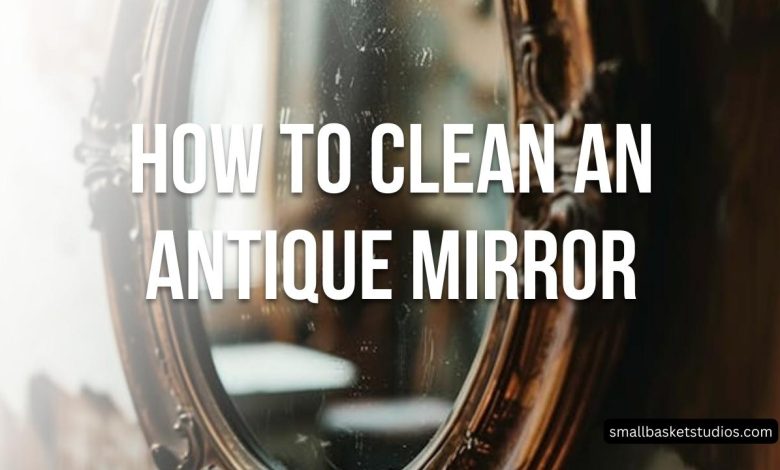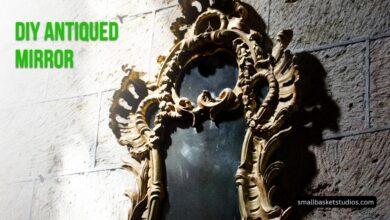How To Clean An Antique Mirror?

Antique mirrors are not just functional pieces; they are works of art that have stood the test of time, adorning the walls of homes and adding an elegant touch to any space. However, over the years, these treasured mirrors can accumulate grime, tarnish, and other forms of buildup, obscuring their once-radiant beauty. Cleaning an antique mirror requires a delicate approach, as improper techniques can cause irreparable damage to the delicate surface or framework.
We will explore the intricate art of cleaning antique mirrors, equipping you with the knowledge and skills necessary to restore these timeless pieces to their former splendor. From understanding the different types of mirrors to mastering the techniques of gentle cleaning, this article will serve as your trusted companion in preserving the legacy of these exquisite treasures.
Understanding Antique Mirrors:
Before delving into the cleaning process, it is essential to understand the different types of antique mirrors and their unique characteristics. Antique mirrors can be classified into three main categories: mercury mirrors, silvered mirrors, and modern mirrors.
- Mercury Mirrors: These mirrors, commonly found in pieces dating back to the 16th to the mid-20th century, feature a reflective surface created by applying a thin layer of mercury behind the glass. Mercury mirrors are extremely fragile and require utmost care during cleaning, as the mercury can be hazardous if disturbed or ingested.
- Silvered Mirrors: Silvered mirrors, which became popular in the mid-19th century, have a reflective surface created by applying a thin layer of silver behind the glass. While more durable than mercury mirrors, silvered mirrors can still be susceptible to tarnishing and discoloration over time.
- Modern Mirrors: Contemporary mirrors, manufactured from the mid-20th century onwards, typically feature a reflective coating made of aluminum or other modern materials. These mirrors are generally more robust and less prone to damage during cleaning.
Preparing for the Cleaning Process:
Before embarking on the cleaning journey, it is crucial to gather the necessary supplies and create a suitable workspace. Here are the essential items you’ll need:
- Soft, lint-free cloths or microfiber towels
- Distilled water
- Mild soap or specialized mirror-cleaning solution
- Cotton swabs or soft-bristled brushes (for intricate details)
- Gloves (for handling mercury mirrors)
- Well-ventilated workspace
Additionally, it is advisable to conduct a spot test on an inconspicuous area of the mirror to ensure the cleaning solution does not cause any adverse reactions or damage.
Step-by-Step Cleaning Guide:
Now that you’ve gathered the necessary supplies and prepared your workspace, it’s time to dive into the cleaning process. Follow these step-by-step instructions to ensure a safe and effective cleaning experience:
- Gentle Dusting: Begin by gently dusting the mirror’s surface with a soft, lint-free cloth or microfiber towel. This initial step will remove loose dirt, dust, and debris, preventing them from scratching the mirror during the cleaning process.
- Mixing the Cleaning Solution: For mercury and silvered mirrors, it is recommended to use a mixture of distilled water and a mild soap or specialized mirror-cleaning solution. Avoid using harsh chemicals or abrasives, as they can damage the delicate reflective surface.
For modern mirrors, you can opt for a commercial glass cleaner or a DIY solution of equal parts distilled water and white vinegar.
- Applying the Cleaning Solution: Dampen a clean, lint-free cloth or microfiber towel with the cleaning solution. Gently wipe the mirror’s surface in a circular motion, working from the center outwards. Avoid excessive pressure or scrubbing, as this can scratch or damage the mirror.
- Intricate Details: For intricate details or hard-to-reach areas, use cotton swabs or soft-bristled brushes dipped in the cleaning solution. Gently clean these areas, taking care not to apply excessive pressure or force.
- Rinsing and Drying: Once you’ve cleaned the entire mirror surface, use a fresh, damp cloth or microfiber towel to gently rinse away any remaining cleaning solution. Ensure no residue is left behind, as it can lead to streaking or discoloration.
Next, use a dry, lint-free cloth or microfiber towel to gently buff and dry the mirror’s surface. Avoid circular motions during this step, as they can create unwanted streaks or smears.
- Final Touch-ups: After the initial drying process, closely inspect the mirror for any remaining streaks, smudges, or imperfections. Use a clean, dry microfiber cloth to gently buff and polish the surface until it achieves a flawless, streak-free finish.
Special Considerations for Mercury Mirrors:
Mercury mirrors require extra precautions due to the potential health hazards associated with mercury exposure. Here are some important considerations:
- Always wear gloves when handling or cleaning mercury mirrors to prevent mercury absorption through the skin.
- Ensure proper ventilation in your workspace to minimize the risk of inhaling mercury vapors.
- Avoid applying excessive pressure or force, as this can cause the mercury backing to separate from the glass, releasing hazardous vapors.
- If you notice any signs of damage or separation, immediately stop the cleaning process and seek professional assistance for safe mercury removal and disposal.
Maintaining and Preserving Antique Mirrors:
Proper maintenance and preservation are crucial to ensure the longevity and beauty of your antique mirrors. Here are some tips to keep in mind:
- Avoid direct sunlight exposure, as it can cause discoloration and fading over time.
- Maintain a consistent temperature and humidity level in the room where the mirror is displayed to prevent warping or cracking.
- Periodically dust the mirror and its frame using a soft, dry cloth or brush to prevent buildup.
- Consider investing in specialized mirror cleaners and polishes specifically designed for antique mirrors.
- When not in use, store the mirror in a cool, dry place, wrapped in acid-free paper or cloth to protect it from environmental factors.
Frequently Asked Questions (FAQ):
Can I use regular glass cleaner on antique mirrors?
It is generally not recommended to use regular glass cleaners on antique mirrors, especially those made with mercury or silver backing. These cleaners can be too harsh and potentially damage the delicate reflective surface. Stick to mild soap solutions or specialized mirror-cleaning products.
How often should I clean my antique mirror?
The frequency of cleaning will depend on the mirror’s condition and the environment in which it is displayed. As a general guideline, it is advisable to clean antique mirrors every 6 to 12 months, or as needed when visible buildup or tarnishing occurs.
Can I use vinegar to clean antique mirrors?
Vinegar can be used to clean modern mirrors, but it is not recommended for antique mirrors, especially those with mercury or silver backing. The acidic nature of vinegar can potentially react with the reflective surface and cause damage over time.
Is it safe to clean antique mirrors while pregnant?
If you are cleaning a mercury mirror while pregnant, it is best to exercise extra caution and take necessary precautions to minimize exposure to mercury vapors. Consider seeking professional assistance or delegating the task to someone else during this time.
Can I use the same cleaning methods for the mirror’s frame?
No, the cleaning methods for the mirror’s frame may differ depending on the material used. Consult a professional or seek guidance specific to the frame’s material to ensure safe and effective cleaning without causing damage.
Conclusion:
Antique mirrors are timeless treasures that deserve the utmost care and attention. By following the comprehensive guide outlined in this article, you can confidently restore the radiant beauty of your antique mirrors while preserving their integrity for generations to come. Remember, patience, gentleness, and attention to detail are key when cleaning these delicate pieces.
Embrace the art of cleaning antique mirrors, and let these magnificent works of art shine once again, adorning your space with their captivating elegance and rich history. Unveil the beauty that has been hidden beneath layers of time, and bask in the splendor of these extraordinary mirrors.


